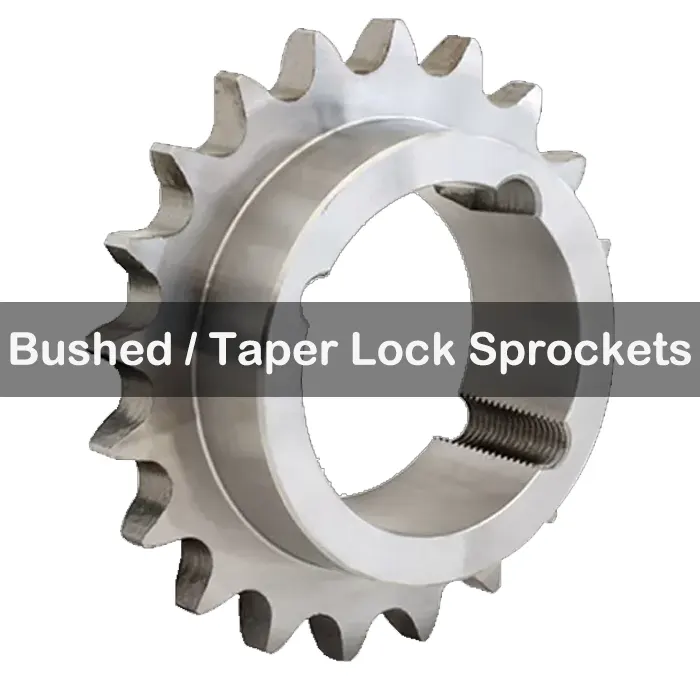Sprockets
Premium Sprockets for Sale
At GBC, we supply top-tier sprockets designed to deliver reliable performance across a wide range of industries. Manufactured with advanced processes, our sprockets are crafted to ensure durability, smooth motion, and consistent output even under tough working conditions. When it comes to sourcing Sprockets in Australia, quality and endurance matter most, and we guarantee both.
Whether for industrial, agricultural, or commercial applications, our sprockets come in many sizes, designs, and configurations to fit the precise requirements of the equipment. Made from high-quality materials that resist wear and keep efficiency over time, every part helps to lower maintenance expenses and downtime.
We gladly provide companies throughout Australia with sprockets that fulfill stringent performance criteria. Australia Drive is renowned for its reasonably priced, dependable, and creative ideas. Our goal is to enable you to maintain the proper operation of your device.
GBC – Where quality engineering meets trusted performance. Let your machinery move stronger and last longer with sprockets crafted for Australia’s toughest demands.
Sprockets by Structures
Sprockets by Applications
Agricultural Sprockets
Boiler Sprockets
Bucket Elevator Sprockets
Conveyor Sprockets
Hoist Sprockets
Scraper Conveyor Sprockets
Sprockets by Materials
Cast Iron Sprockets
Plastic Sprockets
Stainless Steel Sprockets
Steel Sprockets
Sprockets by Different Standards
Sprockets Types
The American Society of Mechanical Engineers (ASME, formerly known as ANSI) has implemented several standards that not only establish minimum requirements for sprockets but also create categories for different types of sprockets. ASME identifies sprockets based on their dimensions, pitch and general types. There are three types of sprockets, each with a hub style:
- Type A sprockets have no hub
- Type B sprocket has a hub on one side
- C-type sprocket has a hub on each side
What Is the Function of a Sprocket?
A sprocket is a disc-shaped part that achieves the purpose of transmission and rotation through the meshing of chains. Sprockets are generally made of steel and mainly consist of gear teeth and a center hole. The gear teeth of the sprocket must match those of the chain to ensure the accuracy and stability of power transmission. The hole diameter of the sprocket is selected according to the size of the drive shaft, and usually there are multiple specifications to choose from.
What Is the Main Difference Between a Sprocket and a Pulley?
A sprocket is a toothed wheel that engages with a chain or track to transmit rotational motion and torque, typically in systems like bicycles or machinery. A pulley is a grooved wheel designed to guide or support a belt, rope, or cable, often used to transmit power or change the direction of force in systems like conveyor belts or lifting mechanisms. The main difference lies in their engagement: sprockets use teeth for positive drive with chains, ensuring no slip, while pulleys rely on friction with belts or ropes, which may allow slip under load.
Principle for Selecting the Number of Teeth of Chain Drive Sprockets
- Transmission ratio and speed:
Match the number of teeth on the sprocket to achieve a reasonable speed conversion. - Range of teeth:
A small number of teeth is prone to cause the chain to elongate and reduce the accuracy. A large number of teeth reduces impact.
The number of teeth on the small sprocket should not be too small to prevent chain wear. Excessive teeth on the large sprocket increase its size and weight. - Dynamic performance:
Avoid odd-numbered teeth and reduce dynamic loads.
Avoid having a common divisor between the number of teeth and the number of chain links to prevent resonance. - Power and Load Capacity:
The number of teeth is selected based on the transmitted power. For heavy-duty transmission, the number of teeth is increased to enhance the load-carrying capacity
When operating at high speed and under heavy load, increasing the number of teeth can improve the working conditions of the chain.
- Chain and Meshing:
Ensure that the chain can be smoothly meshed in and out to prevent it from coming apart.
Consider the chain model, specification, pitch error and elastic deformation. - Transmission smoothness:
The difference in the number of teeth between adjacent sprockets should not be too large to reduce uneven force distribution on the chain.
Increasing the number of teeth reduces vibration and improves transmission accuracy. - Noise and Lifespan:
High-speed transmission increases the number of teeth to reduce noise.
A reasonable number of teeth extends the fatigue life of the chain and reduces wear. - Structure and Installation:
Consider the installation space, the diameter of the sprocket and the system layout.
Avoid increasing the bending stress of the chain by too many teeth. - Efficiency and Cost:
Take into account transmission efficiency, manufacturing process and cost.
Select the number of teeth that conforms to the standardized series. - Working condition adaptability:
Low-speed transmission can reduce the number of teeth, while frequent starts and stops require careful selection.
Consider the lubrication conditions, working environment and tension. - Maintenance and Reliability:
Select the number of teeth that is easy to maintain to ensure the reliability of the system.
The number of teeth helps to extend the service life of the transmission system.
Sprockets in Australia
At GBC, we are proud to supply high-quality sprockets across Australia, serving industries ranging from mining and agriculture to manufacturing and logistics. Our sprockets have now expanded their reach to cover states like New South Wales, Victoria, and Queensland. In cities such as Sydney, Melbourne, Brisbane, Adelaide, and Perth, our sprockets are actively selling and earning a solid reputation.
Our sprockets are engineered for durability, precision, and performance, ensuring seamless operation even under the toughest conditions. With a wide range of standard sizes and custom solutions available, we meet the unique needs of businesses nationwide. Trust us for reliable sprockets crafted to keep your operations running smoothly. Experience the difference with our commitment to excellence, local support, and fast delivery across Australia.

